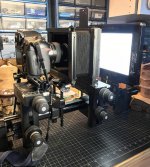Andprayforrain
Member
Does anyone know how well a Nikon D850 (or any comparable digital camera) scans BW negs compared with a Nikon COOLSCAN V?
The COOLSCAN has an effective resolution of 3,900 pixels per inch, so it can obtain enough info for a 20” print with 275 pixels per inch, or a 16” print with 345 pixels per inch. That’s about 20.4 megapixels.
I have no problem with the amount of detail the COOLSCAN can obtain. However, I do have a problem with the amount of grain aliasing it produces, which can become excessive when processing low-contrast and other less-than-ideal negatives. Generally, the more contrast that must be added, the more apparent the aliasing, and every COOLSCAN file from a BW neg requires a significant boost in contrast.
So:
More generally:
I refer specifically to the D850 because I’m considering getting one. Feel free to refer to any other comparable camera.
The COOLSCAN has an effective resolution of 3,900 pixels per inch, so it can obtain enough info for a 20” print with 275 pixels per inch, or a 16” print with 345 pixels per inch. That’s about 20.4 megapixels.
I have no problem with the amount of detail the COOLSCAN can obtain. However, I do have a problem with the amount of grain aliasing it produces, which can become excessive when processing low-contrast and other less-than-ideal negatives. Generally, the more contrast that must be added, the more apparent the aliasing, and every COOLSCAN file from a BW neg requires a significant boost in contrast.
So:
- Can a D850 with, say, an AF-S Micro NIKKOR 60mm f/2.8G ED obtain greater detail versus the COOLSCAN?
- Does the D850 do a noticeably better job of rendering grain?
More generally:
- On the overall scale of scanning--from consumer level scanners, through COOLSCANs, through Hasselblad scanners, to drum scanners--how does D850 scanning generally rate?
- Does anyone have close-up examples of BW negative grain scanned using the D850 versus that using a scanner comparable to the COOLSCAN V?
I refer specifically to the D850 because I’m considering getting one. Feel free to refer to any other comparable camera.




